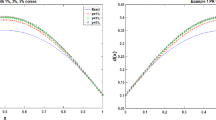Abstract
In the context of the linear theory of thermoelasticity without energy dissipation for homogeneous and isotropic materials, the uniqueness of solution of a natural initial, mixed boundary value problem is proved. The proof depends on an equation of energy balance formulated entirely in terms of temperature and velocity fields.
Similar content being viewed by others
References
A.E. Green and P.M. Naghdi, Thermoelasticity without energy dissipation.J. Elasticity 31 (1993) 189–208.
D.S. Chandrasekharaiah, Thermoelasticity with second sound — A review.Appl. Mech. Rev. 39 (1986) 355–376.
J. Ignaczak, Generalized Thermoelasticity and its applications. In R.B. Hetnarski (ed.),Thermal Stresses III. Elsevier Science Publishers (1989) pp. 280–353.
D.D. Joseph and L. Preziosi, Heat Waves.Revs. Mod. Phys. 61 (1989) 41–73 and addendum62 (1990) 375–391.
Author information
Authors and Affiliations
Rights and permissions
About this article
Cite this article
Chandrasekharaiah, D.S. A note on the uniqueness of solution in the linear theory of thermoelasticity without energy dissipation. J Elasticity 43, 279–283 (1996). https://doi.org/10.1007/BF00042504
Received:
Issue Date:
DOI: https://doi.org/10.1007/BF00042504



